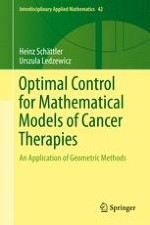2015 | OriginalPaper | Buchkapitel
8. Optimal Control for Mathematical Models of Tumor Immune System Interactions
verfasst von : Heinz Schättler, Urszula Ledzewicz
Erschienen in: Optimal Control for Mathematical Models of Cancer Therapies
Verlag: Springer New York
Aktivieren Sie unsere intelligente Suche, um passende Fachinhalte oder Patente zu finden.
Wählen Sie Textabschnitte aus um mit Künstlicher Intelligenz passenden Patente zu finden. powered by
Markieren Sie Textabschnitte, um KI-gestützt weitere passende Inhalte zu finden. powered by
